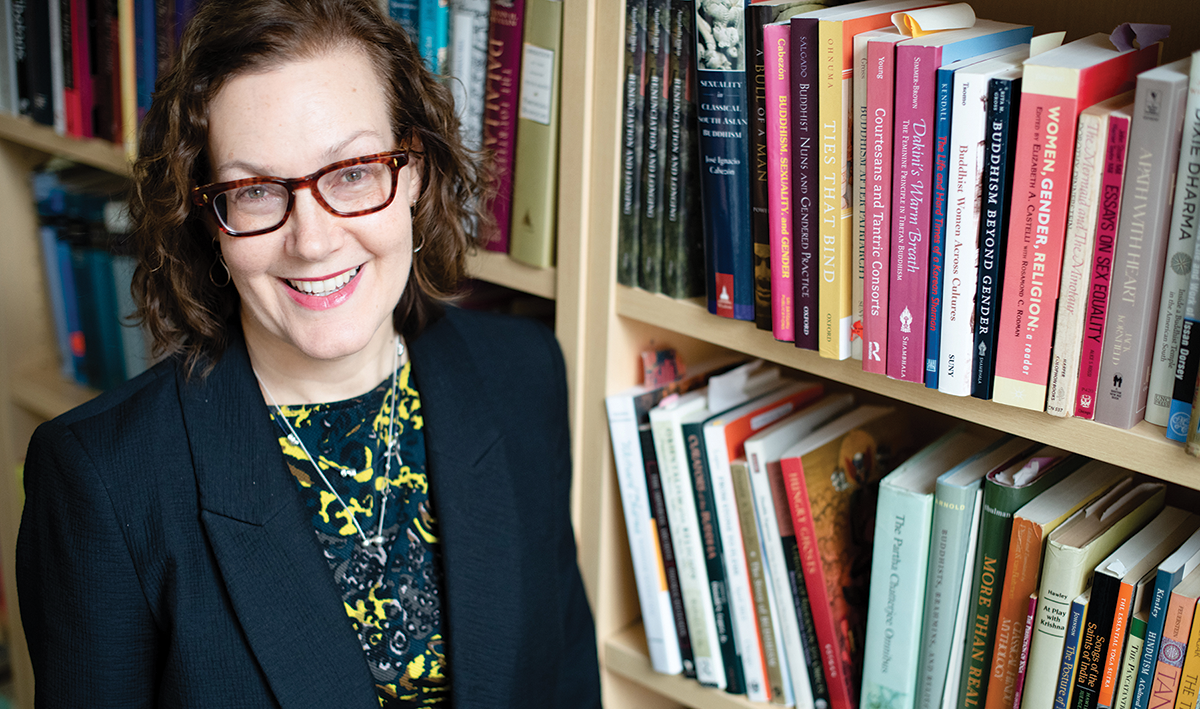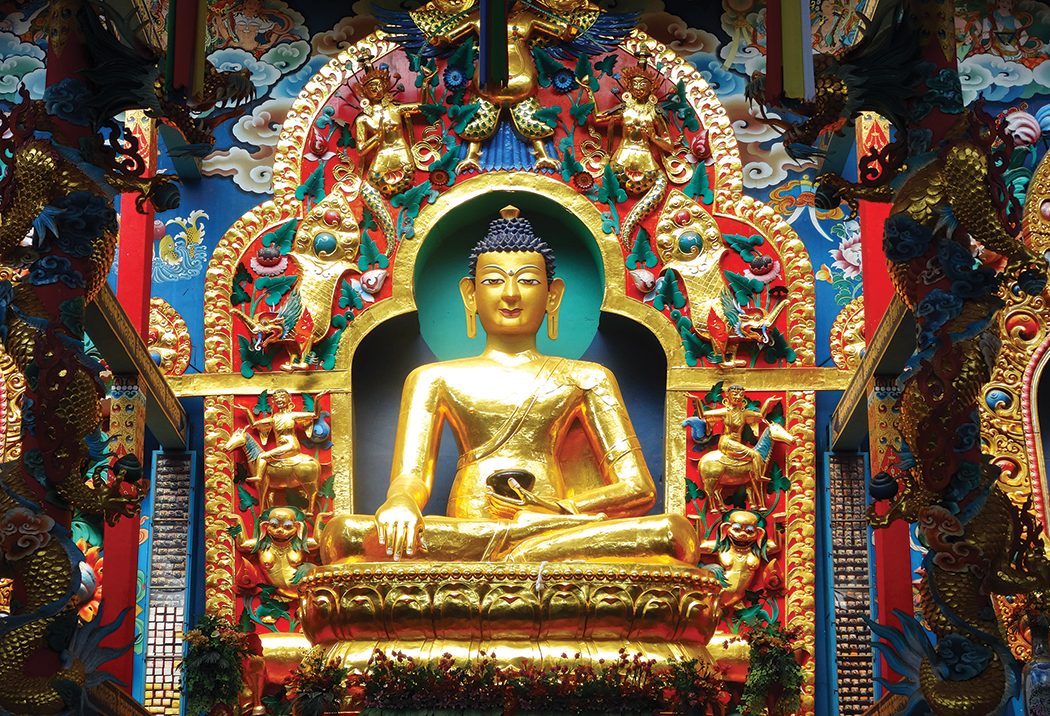Annabella Pitkin examines how communities respond to trauma, address suffering, and renew transformative relationships through practices of memory
Annabella Pitkin grew up in New York City, with its contradictions like unprecedented prosperity amidst stark poverty. As a teenager, the impact of the city’s extremes inspired Pitkin to become politically and socially active and engage with issues like hunger and homelessness.
“My parents and I talked a lot about the historical context and processes that were involved in creating the situations we were seeing in our day—that sense that you can't separate the present from history, but also that history is transformative when you understand how it shapes your life.”
Today, Pitkin explores historical and social questions as an associate professor of religion studies. She earned her interdisciplinary bachelors in social studies from Harvard University and her doctorate in Buddhist Studies from Columbia University.
“My interdisciplinary background in the study of religion means I’m trained to think about the intersection of historical processes with literary and cultural practice,” Pitkin says. “That interdisciplinary approach, plus my immersion in Tibetan sources and training in Buddhist philosophy really opened up the research avenues that came together in [my recent] book.”
Pitkin, who is also director of Lehigh’s Asian studies program, spent a significant amount of time during her undergraduate years studying political philosophy.
“But as I started to get interested in applying to graduate school,” Pitkin says. “I felt like the study of religion offered the widest array of ways to investigate how communities make meaning, respond to trauma, and navigate social change. That was what ultimately resulted in my applying to graduate school in religion at Columbia.”
Discovering Khunu Lama
As she progressed in her religion studies, Pitkin felt that Tibetan and Himalayan Buddhist thinkers were doing the most interesting work with her research questions. Because of that, her dissertation adviser, Robert Thurman, suggested that she investigate the life of Khunu Lama, a Buddhist scholar-meditator born in 1894 in the Himalayan region, who journeyed across Tibet and India during the early 20th century and taught a generation of leading Tibetan Buddhist figures, including the Fourteenth Dalai Lama.
“My adviser made this suggestion,” Pitkin says, “and then a wonderful piece of Buddhist coincidence occurred. I was in a bookstore with my mother when she pulled a book off the shelf that turned out to be a translation of Khunu Lama’s poems. As I began to read, I realized that Khunu Lama’s own poetry, and the stories people told about him, all centered on the themes I'd been trying to approach for several years.”
That’s when Pitkin decided to pursue a project that would ultimately become her book
Renunciation and Longing: The Life of a Twentieth-Century Himalayan Buddhist Saint, published last May. The book is in part a biography. But it is also a thematic reflection on questions of relationship, suffering, and how Tibetan and Himalayan Buddhists have used stories of renunciation and devotion to maintain cultural continuity during a period of unprecedented loss.
“What I embarked on, as I learned more about Khunu Lama’s life, was a study of his practice of renunciation. I came to appreciate the Buddhist ideal of renunciation – perhaps counterintuitively – as a core aspect of imagining Buddhist relationships,” Pitkin says.
Renunciation is a very old Buddhist idea; in fact, it goes back about 2,500 years to the eponymous Buddha himself, Siddhartha Gautama. According to Buddhist sources, Gautama was born to royal parents but renounced the privileges and pleasures of his home life to live as a wandering ascetic before famously attaining enlightenment.
“One of the things I talk about in the book is how Tibetan authors describe renunciation as potentially taking many forms. There are important figures in Tibetan and Himalayan Buddhist literature who left everything behind to go meditate in a cave for 20 years,” Pitkin says. “But there have also been people who continue to live in the world, and maybe even play a very active role, politically, socially, or economically, who are says to have an inner attitude of renunciation.”
In her book, that ideal of renunciation, external or internal, is the lens through which Pitkin examines themes of loss and continuity. Tibetan and Himalayan authors describe renunciation as shaping teacher-student relationships, potentially imposing painful separations that are in turn overcome by practices of devotion, memory, and narrative. Pitkin’s book argues for the importance of this intellectual tradition in understanding times of great political, social, or cultural upheaval—such as the experiences of Tibet and the Himalayan region during the 20th century.
“That’s where the intervention of the book lies, looking at this Tibetan and Himalayan intellectual tradition, and specifically at the theme of renunciation, through the frame of one person's life in the crucible of the 20th century,” Pitkin says. “I argue that Khunu Lama’s life, writings and activities—particularly narratives about his renunciation—create opportunities to see how the whole received binary of modern versus not-modern falls apart.”
“I’m writing against ways of thinking about modernity that suggest a kind of hierarchy,” Pitkin says, “where some societies are labeled ‘truly’ modern and others aren't, or where people who are labeled ‘not-modern’ are framed as primitive or backward.”
“That kind of modernity-as-progress story often gets framed as benevolent helpfulness by governments and other powerful actors, but that progressivist way of thinking about modernity can actually be a tool of enormous cultural violence,” Pitkin added. “By contrast, Khunu Lama’s own writings, and work by Himalayan and Tibetan authors about Khunu Lama’s life, reveal more nuanced and capacious ways of thinking about 20th century history and its disruptions, using interpretive tools drawn from Buddhism.”
Emotion and Affect in the Classroom
In addition to the themes of renunciation and modernity, one of the things Pitkin took away from her deep dive into Khunu Lama’s life was a sense of the creation and transmission of knowledge as a relational process, and how emotion and affect are central to Buddhist modes of interpersonal connection—especially between teachers and students.
“I feel like my own teaching has really evolved as a result,” Pitkin says. “Over the same period that I've been working on this book, I've also been rethinking how I imagine the space of the classroom, starting to understand it as a place where the students and I are exploring questions together and producing knowledge together.”
“The learning is coming from the students,” Pitkin added. “It's not something that I'm single-handedly providing to them. But rather, we're making something together. And that's a relational process. It's a process of discovery in each class, and there is a way in which I think that approach comes from my learning about the kind of teacher Khunu Lama was.”








